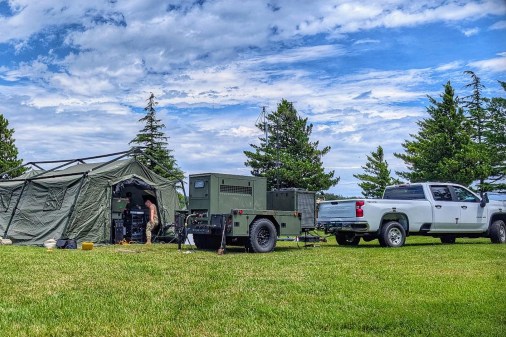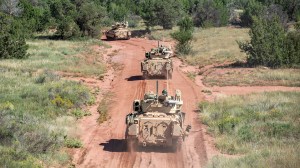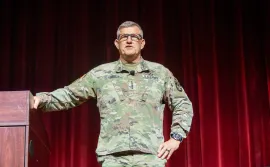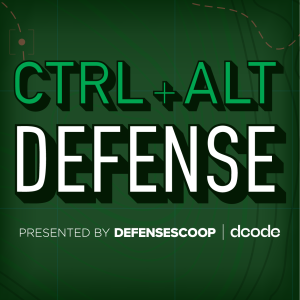Next summer could be culmination of bridge network and next-gen C2 for the Army

ABERDEEN PROVING GROUND, Md. — Project Convergence Capstone 6 will be the cut line for when the Army aims to transition from bridge networking capability to its Next Generation Command and Control program, according to officials.
NGC2 is one of the Army’s highest priorities. Service officials have said it will be a “clean slate” from legacy capabilities and architectures encompassing a full stack approach, meaning it will focus on everything from transport to data to applications to cybersecurity.
The Army is looking to pick up the momentum following what it says was a successful demonstration of a NGC2 prototype “proof of principle” at the Project Convergence Capstone 5 event at the National Training Center at Fort Irwin, California, in March. That event saw a battalion operating in a scenario against a live opposing force using technologies associated with NGC2.
As that prototype is matured going forward and the program office seeks to make awards as part of the official program of record, officials have said Project Convergence Capstone 6, slated for the summer of 2026, will likely be when the Army starts to transition from legacy capabilities to beginning to make decisions and field NGC2 systems.
“Post PCC6, we’re going to reassess ourselves. We’re going to see … what’s the right composition looks like, what’s the right contracting approach. Then at the end, as we go forward, we’d like to establish pools that allow truly best-of-breed technologies to work their way into this formation … Think of a transport pool, infrastructure pool, a data layer and apps,” Brig. Gen. Kevin Chaney, acting program executive officer for command, control, communications and network, said at the 14th Technical Exchange Meeting at Aberdeen Proving Ground, Maryland, on May 30.
These events gather members of industry, the Army acquisition community, Army Futures Command and operational units to outline priorities and capabilities to modernize the service’s tactical network. They have occurred twice a year. The most recent iteration was initially slated to take place in Dallas, but due to travel restrictions imposed by the Department of Defense, the event was moved closer to the National Capital Region and lasted one day instead of two.
In parallel to NGC2, the Army has been executing what it calls C2 Fix, which seeks to use what the service already has, along with commercial off-the-shelf technology, to enhance the network tools for soldiers’ so-called “fight tonight” capability. That effort is already in its seventh iteration. While initially focused on the near term, it has evolved into somewhat of a bridge capability between legacy systems and NGC2, with officials calling it a down payment on the next-generation tech.
Chaney said that eventually, the Army needs to take a “leap of faith” to when that C2 Fix bridge transitions to NGC2.
“At the end of the day, we’re going to have to pick a point in time and make that leap of faith. I think we see 4th [Infantry Division] and PCC6 as that line where we have to make that leap of faith,” he said in an interview, adding that officials must begin the backwards planning now to be better aligned in the future.
The Army chose 4th Infantry Division to be the test unit to continue to refine the NGC2 prototype. They’ll also work to scale the capability up to division level, to include the headquarters and the enabling units, as the Army is pushing complexity out of brigades and into divisions to be the primary units of action.
While 4th ID will be the main entity testing out and refining the prototype, officials will be asking other units if they’d like to participate as well.
“We’re also asking what are the other divisions that would like to play? We’ve got 25th [Infantry Division] that’s already said we would like to be an experimental unit for another one of those Next Gen C2 solutions,” Chaney said. “We’ve already had discussions with a couple other division commanders, and they’re ready to support.”
They’ll be looking at what the right mix is going forward for what units will be demonstrating, and it might not be the full stack. It could be just the transport and the application layer, for example.
This approach will afford the Army flexibility and allow it to understand how to outfit units that have and haven’t been C2 Fix-enabled.
The prototype and eventual program-of-record equipment will not undergo the traditional developmental and operational tests of programs of the past. Chaney said the test community has been a part of the effort the entire way, having seen the experimentation events.
“They know what we’re doing. And we try to set up realistic scenarios, and they’re trying to get all the data off there they can to make sure that they understand effective, suitable and survivable. We can look at those things as we go forward [and] make more informed decisions,” Chaney said. “It’s also a risk-based approach. At the end of the day, we’re willing to accept some failure because we’re not going to go out there and just pure fleet everybody. It’s going to be an iterative thing. 4th ID will get a Next Gen C2 version. The next division may get a slightly different and better version of it. Then, as we continue to evolve, then I think we’ll work through all the, I would say, traditional programmatic documentation pieces that we have to do.”
Contracting approach
The Army has sought to approach NGC2 differently than other programs in the past.
Officials have described a hybrid contracting approach to NGC2 so as to reduce risk and keep competition open.
The Army received over 80 white papers from industry in response to its commercial solutions offering that closed June 2, according to service officials, including team lead and component submissions.
That commercial solutions offering was left “wide open,” according to officials, so as to not prescribe what the Army wants out of industry.
“I’m excited to see what comes back. I’m also excited to see the feedback, if we are doing this right or if we’re doing it wrong and how we can improve going forward,” Chaney said.
The Army expects contracts to be awarded later this year.
Chaney noted that there will also be other contracts out there to see who has best-of-breed capability as they go forward. Army Contracting Command has an open commercial solutions offering available that won’t close, so companies can continue to offer good ideas that could be onboarded.
The Army has requested self-organized teams of industry to bid either on slices of the program — such as applications or data layer or transport — or the full stack if they think they can do it.
“Even the big, giant companies I don’t think could do all of this. They couldn’t do it in the time frame that we’re looking for,” Chaney said. “If you’re truly trying to get an open system architecture, you’re going to need other people to come in there and start integrating different companies.”
It’ll be up to the industry teams to determine what slices of the NGC2 stack they want to compete for. Some may think they can do the whole thing, which the Army will evaluate.
“We might have a team that says, ‘I can give you everything.’ We’ll look at the risk and see if that makes sense or not. Our market research — and we’ve done a lot of it — has said there’s no one company out there that can do all of this. Teaming up gives us that flexibility going forward of figuring out who’s best of breed,” Chaney said.
He expects to see a wide range of responses to the commercial solutions offering with teams saying they can do certain portions well.
Scaling to division
Officials have acknowledged the complexity in moving NGC2 up to the division level, especially considering the prototype was kitted to mainly the battalion level at the National Training Center.
Network modernization efforts of the past have largely focused on the brigade level. But as the Army seeks to move complexity up and fight as a division, enabling brigades — such as sustainment, aviation, artillery and intelligence — must be equipped with comms gear as well.
As the Army scales to division, these enablers will now begin to be a top focus.
“The chief was really directive with us from the very beginning of this is, as we scale to a division prototype, the division headquarters and enablers, first focus and then trickle down the brigades … Under no circumstances are we going to cut the enablers, because we tend to reverse-engineer our way into that,” Maj. Gen. Patrick Ellis said at the Technical Exchange Meeting on his last day as director of the C2 Cross Functional Team for Army Futures Command.
“This is actually next gen, different than the way we’ve done in the past. It’s not going to solve the BCT problem and then figure out how to reverse-engineer that into an aviation unit or a sustainment unit, this division sustainment brigade or division combat aviation brigade. It’s actually — that’s going to be part of the solution,” he added.






